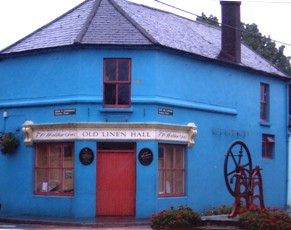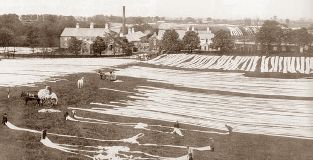- Home ›
- Irish crafts ›
- Spinning Wheel Entitlement Lists
Mill work and flax growers in Ireland
Working in the linen mills
Spinning Wheel Entitlement Lists
In the Irish Linen Homelands of Northern Ireland (chiefly around Lisburn, Belfast, Banbridge and Cookstown), the work of transforming the flax plant into yarn and then into beautiful cloth, eventually moved into huge mills.
You'll find the various job titles used in the mills lower down the page. The job titles are the terms you're likely to see in census returns and other documents.
 The Old Linen Hall in Clonakilty, Co Cork.
The Old Linen Hall in Clonakilty, Co Cork. The Old Linen Hall in Clonakilty, Co Cork
The Old Linen Hall in Clonakilty, Co CorkFor most factory and mill employees, the working week consisted of eleven and a half or twelve hours (including meal breaks) from Monday to Friday plus a half day of six hours on Saturday.
In terms of holiday, workers could take two days for Christmas, two days at Easter and two more days in July. Holiday breaks were not paid.
These terms of employment applied to most staff over the age of thirteen.
The scutching room was one of the most unhealthy because the air was filled with dry flax plant dust called 'pouce' and workers could not avoid inhaling it. As it settled in the lungs, it caused shortness of breath and many bronchial complaints.
The hackling and carding rooms were the most dangerous because the machines were not properly guarded. Facial and hand injuries, ranging from lacerations to mutilations, were the most common but fatal accidents were also a regular occurrence.
Children in the mills
Children were legally permitted to work at the mills from about the age of ten years on a part-time basis. They usually spent alternate days at the mill, typically working as doffers (replacing full yarn bobbins on the spinning frames with empty ones), and in the classroom. When they first started work, many suffered what became known as 'mill fever' before they adjusted to the high temperatures, damp or dusty environments, noise and exhaustion.
Children in the mills
Children were legally permitted to work at the mills from about the age of ten years on a part-time basis. They usually spent alternate days at the mill, typically working as doffers (replacing full yarn bobbins on the spinning frames with empty ones), and in the classroom. When they first started work, many suffered what became known as 'mill fever' before they adjusted to the high temperatures, damp or dusty environments, noise and exhaustion.
One of the dirtiest places to work in the mill was the spinning room. Temperatures were hot and humid and workers tended to be barefoot.
In a study into the health of mill workers in 1852, it was found that spinning room workers were suffering from 'onychia and other diseases of the great toe nail' as a result of their feet getting wet with water impregnated with brass and other metals. They were also found to suffer skin problems.
In the weaving shed, noise and humidity were the main discomforts to be endured. The noise was caused by the carding machines, the looms and shuttles, while the dampness and heat was fed in to create the conditions needed for weaving yarn. But at least weavers had the satisfaction of earning higher wage rates than other mill workers.
With such unhealthy work, the mortality rate in the spinning mills and weaving factories was high. In the late 19th century, the average working life was 16.8 years.
 A Bleaching Green in Co. Antrim
A Bleaching Green in Co. AntrimBleachers worked at the bleachworks where serious accidents and incidences of fever were fewer than in the spinning mills and weaving factories. Even so, the work was backbreaking. Longer summer daylight hours meant bleachers often worked from 5.30am to 6pm Monday to Friday and 5.30am to 3pm on Saturdays. Less than two hours were allowed for breakfast and dinner.
These long days helped to subsidise the shorter working hours of winter.
 A Bleaching Green in County Antrim
A Bleaching Green in County AntrimBleachers worked at the bleachworks where serious accidents and incidences of fever were fewer than in the spinning mills and weaving factories. Even so, the work was backbreaking. Longer summer daylight hours meant bleachers often worked from 5.30am to 6pm Monday to Friday and 5.30am to 3pm on Saturdays. Less than two hours were allowed for breakfast and dinner. These long days helped to subsidise the shorter working hours of winter.
Mill workers' job titles
These are some of the job titles given to mill workers right up to the 20th century:
Ap iron turner; Carder; Carding master; Carpenter; Cleaner; Doffer; Drawer; Doubler; Fitter; Flax looser; Hackler; Layer; Lorry driver; Oiler; Packer; Piecer; Reeler; Ring oiler; Rover; Screwer; Spinner; Spreader; Storeman; Sweeper; Tenter; Tippler; Tow baler; Trucker; Winder; Yarn boy; Yarn counter; Yarn tucker.
Spinning
Wheel Entitlement List
Mill workers' job titles
These are some of the job titles given to mill workers right up to the 20th century:
Ap iron turner; Carder; Carding master; Carpenter; Cleaner; Doffer; Drawer; Doubler; Fitter; Flax looser; Hackler; Layer; Lorry driver; Oiler; Packer; Piecer; Reeler; Ring oiler; Rover; Screwer; Spinner; Spreader; Storeman; Sweeper; Tenter; Tippler; Tow baler; Trucker; Winder; Yarn boy; Yarn counter; Yarn tucker.
In 1796, the Irish Linen Board published its Spinning Wheel Entitlement List (also known as the Flax Growers Bounty or the Irish Flax Growers List), one of several lists created in response to special initiatives by the Government to encourage the production of linen.
Nearly 1796 List all these initiatives involved giving away spinning wheels and looms to individuals. This list was no exception.
It includes the names of persons who had cultivated a specified acreage of flax plant. Those who had planted one acre were awarded four spinning wheels while five acres of flax plant was rewarded with a loom.
Due to the dearth of pre-1800s nationwide resources for genealogists, this 1796 list is worth consulting as part of your family history research even though it contains no mention of townlands.
It is arranged by civil parish (and occasionally only the barony) and contains the names of nearly 60,000 individuals in all counties of Ireland except Dublin and Wicklow who had sown the required acreages of flax plant.
- Did your ancestors cultivate the flax plant?
Search the 1796 Flax Growers List .
Related Pages and Quick Links
